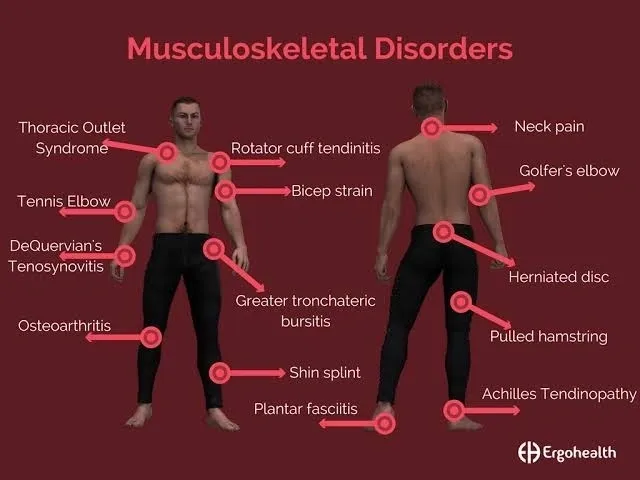Choose one of the following health dysfunctions: musculoskeletal, metabolic, or multisystem. Describe pathophysiological changes, abnormal findings, and symptoms of the chosen health dysfunction. How does it affect the patient’s functions?
Musculoskeletal health dysfunctions comprise various conditions affecting bone, tendons, joints, ligaments, and connective tissues. Musculoskeletal health dysfunctions might be congenital, hereditary, or acquired pathological processes. In this case, the impairment can arise from infections, inflammation, neoplasms, metabolic processes, degenerations, or even traumatic events.

Musculoskeletal dysfunctions entail muscle strains, back pain, tendinopathies, bone fractures or dislocations, and ligament tears. The main symptoms of musculoskeletal health disorders include pain, inflammation, warmth, and tenderness over the injured body part. Joint noises, loss of joint range of motion, change in skin color, especially redness over the injured body part, and general loss of mobility and functional capacity are notable signs of symptoms (Erker, 2022). However, the symptoms vary depending on the musculoskeletal disorder (Musculoskeletal health dysfunctions).
Notably, the first response to injury is pain. The body’s nociceptors react depending on the injury, causing mechanisms such as high mechanical pressure, loss of blood supply, irritating chemicals, and extreme heat or cold. Secondly, inflammatory changes result from body tissues’ response to injury. Inflammation is an acute response to protect the body from further injury by eliminating pathologic agents at the injury site and initiating body tissue repair. Sometimes the abnormal immunologic responses target their body tissues, causing inflammation. For instance, Rheumatoid arthritis results from an autoimmune response affecting the musculoskeletal system.
Musculoskeletal health dysfunctions affect the patients’ functions. Of importance, the musculoskeletal system supports the body’s weight, aid in movement, and maintain posture. Musculoskeletal disorders are linked to pain and loss of dexterity and reduce the patients’ functional activity levels (National Academies of Sciences, Engineering, and Medicine.(2020) (Musculoskeletal health dysfunctions).
Limitations in mobility render the patient dependent on performing Activities of Daily Living (ADLs) such as bathing, dressing, feeding, and toileting. Loss of functions limits the patient from participating in leisure, societal, and income-generating activities involving physical activity. Notably, severe loss of functional activity levels caused by musculoskeletal health dysfunctions leads to disability.
References
Eker, D. (2022). Common Musculoskeletal Disorders Encountered in the Primary Care Setting. Textbook of Adult-Gerontology Primary Care Nursing: Evidence-Based Patient Care for Adolescents to Older Adults, 391.
National Academies of Sciences, Engineering, and Medicine. (2020). Musculoskeletal Disorders. In Selected Health Conditions and Likelihood of Improvement with Treatment. National Academies Press (US).
DQ 2 Topic
Explain the modifiable and nonmodifiable risk factors for osteoporosis. How can a nurse support the patient to manage the health condition and restore the patient to optimal health? (Musculoskeletal health dysfunctions)
Osteoporosis is a slowly progressive disorder initiated by an imbalance between bone formation and resorption. In this case, the bone resorption rate tends to be higher than the bone formation rate. A significant loss of bone mineral density from altered bone microstructure makes the bone porous (Porter et al., 2022). For this reason, the patient’s bones are highly predisposed to fragility and low-impact fractures. Notably, the risk factors for osteoporosis are modifiable and nonmodifiable. While modifiable (preventable) factors are improved, changed, or eliminated to reduce the likelihood of ailing from osteoporosis, nonmodifiable risk factors cannot be improved or changed.
The nonmodifiable risk factors for osteoporosis entail age, history of falls, gender, family history, and post-menopausal women. On the contrary, the modifiable risk factors comprise inadequate nutrient reabsorption, smoking, alcohol intake, exposure to sunlight, physical activity, history of falls, and underlying conditions such as systemic Lupus Erythematosus or rheumatoid arthritis (Blackie, 2020). The risk for osteoporosis increases after thirty years since the bone resorption rate is higher than formation. Post-menopausal women aged about 50 have a risk of osteoporosis since they are also at higher risk since a decrease or decline in estrogen levels makes the bone weaker. Oestrogen slows the natural breakdown process. Women are also more prone to osteoporosis due to their lighter bones than men.
Subsequently, inadequate intake of calcium causes reduced bone mineral density leading to osteoporosis. Smoking and alcohol intake causes an imbalance in bone turnover processes leading to low mineral density. Also, lack of exposure to adequate sunlight as a primary non-nutritional source of Vitamin D predisposes people to osteoporosis. Physical inactivity leads to reduced bone mineral density while underlying musculoskeletal disorders increase the risks of osteoporosis (Musculoskeletal health dysfunctions).
Nurses play an instrumental role in assessing the patient’s knowledge of osteoporosis and its risk factors. Consequently, nurses offer health education about adequate dietary intake, prevention of falls, regular bone density screening, lifestyle choices (smoking and alcohol intake cessation), and the importance of physical activity toward improving bone mineral density (Porter et al., 2022). Nurses also diagnose and manage patients. In this case, they assess the patient’s physical functioning and self-care. Nurses encourage weight-bearing activities, correct posture, and assist patients with self-care.
References
Blackie, R. (2020). Diagnosis, assessment, and management of osteoporosis. Prescriber, 31(1), 14-19.
Porter, J. L., Varacallo, M., & Castano, M. (2022). Osteoporosis (Nursing). In StatPearls [Internet]. StatPearls Publishing.
